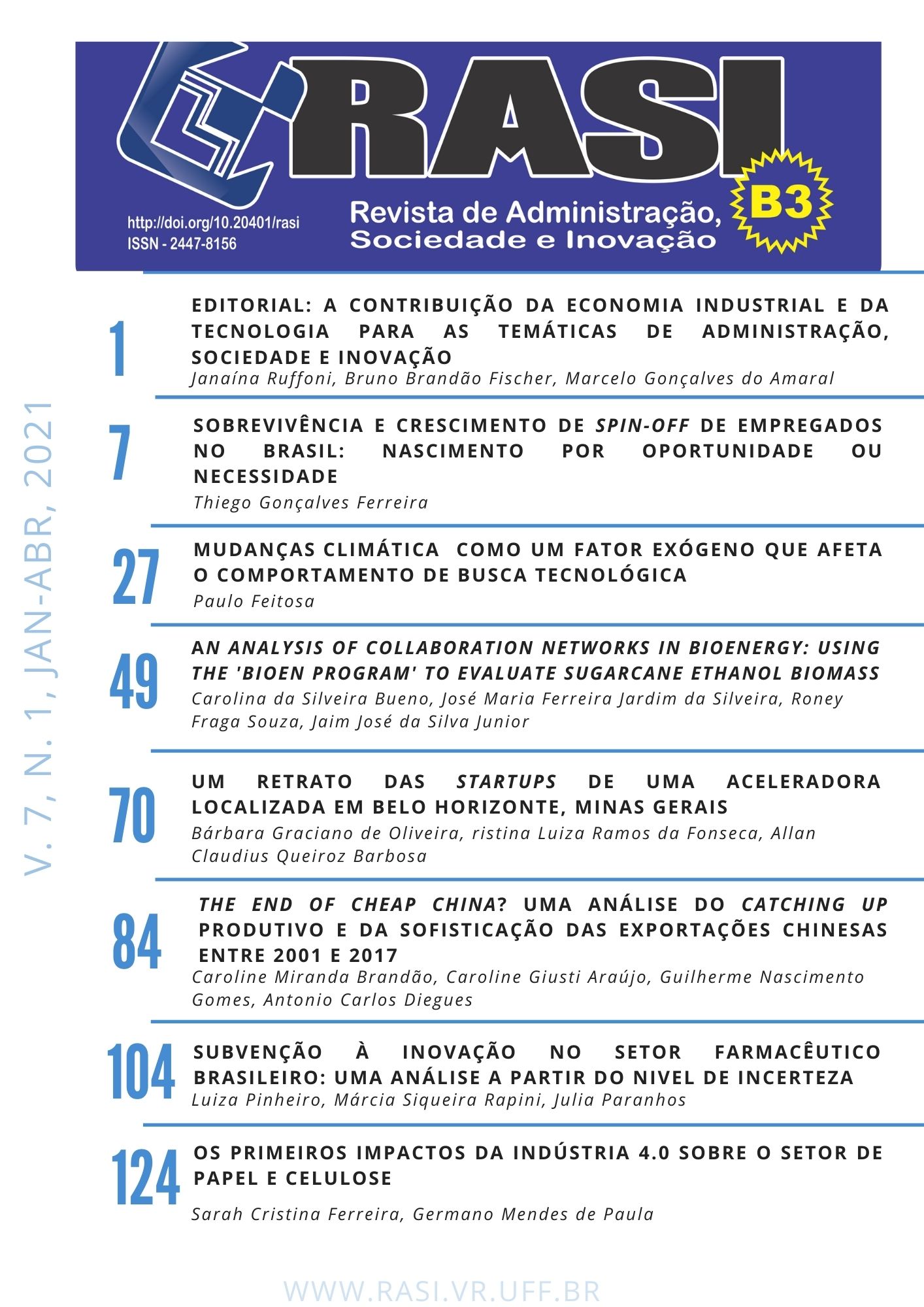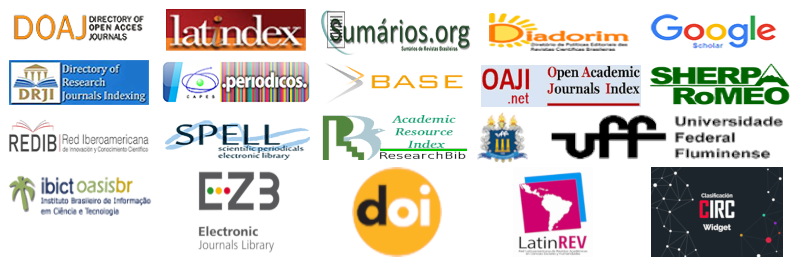An Analysis of Collaboration Networks in Bioenergy:
Using the ‘Bioen Program’ to evaluate ethanol biomass
DOI:
https://doi.org/10.20401/rasi.7.1.516Keywords:
BIOEN-FAPESP, Agricultural Biotechnology, Collaboration Networks, Biomass.Abstract
This article analyzes the indicators of knowledge generation in sugarcane biomass. The impact of the FAPESP research program on bioenergy (BIOEN) is also analyzed, with a focus on the division of biomass and its subareas. Using detailed information from scientific articles in the subareas of Enzymatic hydrolysis, molecular markers, delignification, genotypes, enzymatic conversion, gene expression, nitrogen and photosynthesis, an evaluation of the international insertion of research and collaboration networks of Brazilian researchers is carried out. The methodology, which was based on the works of Verspagen (2007) and Dal Poz (2006), consists of the formation of clusters of publications indexed on the ISI Web of Science database. The selection of publications is guided by search queries based on keywords related to the subareas of biomass division. The software programs VantagePoint and Pajek are used to support the analysis of the information. The principle objective of the study is to identify the global incorporation of efforts to generate knowledge and technological progress in sugarcane biomass carried out by BIOEN. It was possible to identify a number of factors that influence scientific collaboration in the area of biomass, such as geographic distance and the dynamics of scientific collaboration between countries. An analysis of the biomass division of BIOEN, from a global perspective, showed little cooperation between Latin American countries. The results illustrate that Brazil generates the greatest amount of scientific knowledge regarding sugarcane biomass, however, when the subareas are analyzed separately, scientific publications from the US and China are also predominant.
Downloads
References
ANUÁRIO DA CANA (2011). Brasilian sugar cane yearbook. Editora Gazeta.
BACOVSKY, D., LUDWICZEK, N., OGNISSANTO, M., WORGETTER, M. (2013) Status of advanced biofuels demonstration facilities in 2012: A report to IEA bioenergy task 39.
BELL, M.; PAVITT, K. (1992) National capacities for technological accumulation: evidence and implications for developing countries, World Bank’s Annual Conference on Development Economics, Washington, D.C., USA, 30 April & 1 May 1992.
BABCOCK, B. A., ZHOU, W., (2013). “Impact on Corn Prices from Reduced Biofuel Mandates,” Center for Agricultural and Rural Development (CARD) Publications 13-wp543, Center for Agricultural and Rural Development (CARD) at Iowa State University.
BABCOCK, B.A., POULIOT, S. (2014). “Feasibility and Cost of Increasing US Ethanol Consumption Beyond E10,” Center for Agricultural and Rural Development (CARD) Publications 14-pb17, Center for Agricultural and Rural Development (CARD) at Iowa State University.
BIOTECSUR (2009) Biotecnologia: a chave para o crescimento do Mercosul. Newsletter N° 1 - Ano 2009
BORGES, I. de C., SILVEIRA, J. M. F.J. DA, OJIMA, A. L. R. O. (2013) Constraints and Incentives for Agricultural Biotechnology in Brazil. GMCC 13. Lisbon. Portugal
BRASIL (2012) Empresa de Pesquisas Energéticas. Plano decenal de expansão de energia 2021. Ministério de Minas e Energia
BROWN, R C.; BROWN, T. (2012) Why are we producing Biofuels? Paperback, 341p.
DIAS, M. O. S., JUNQUEIRA, T. L., JESUS, C.D.F., ROSSELL, C.E.V., MACIEL FILHO, R., BONOMI, A. (2012) Improving bioethanol production – comparison between extractive and low temperature fermentation. Appl Energy, Vol.98.
DIAS, M.O.S., JUNQUEIRA, T.L., ROSSELL, C.E.V., MACIEL FILHO, R., BONOMI, A. (2013) Evaluation of process configurations for second generation integrated with first generation bioethanol production from sugarcane. Fuel Process Technology, Vol.109.
FAPESP (2011) Fundação de Amparo à pesquisa do Estado de São Paulo. Disponible in http://www.fapesp.br/bioen/
GIMENEZ, A. B. (2013) Estudo da Difusão de Tecnologia de Extração de Sacarose no complexo Agroindustrial Canavieiro Utilizando Modelos de Simulação Agent-Based. Dissertação de Mestrado. Instituto de Economia da UNICAMP. Campinas.
HALL, J. K.; MARTIN, M. J. C. (2005) Disruptive technologies, stakeholders and the innovation value-added chain: a framework for evaluating radical technology. R&D Management, Vol. 35, Nº 3.
HLPE. (2013). Investing in smallholder agriculture for food and nutrition security. A report by the High Level Panel of Experts on Food Security and Nutrition of the Committee on World Food Security, Rome.
JUST, R.E.; ALSTON, J.M.; ZILBERMAN, D. (2006) Regulating Agricultural Biotechnology: Economics and Policy. New York, Springer,
LEMOS, M. B.; DOMINGUES, E. P.; AMARAL, P. V.; RUIZ, R. M.; ARAÚJO, R.; CALIARI, T. (2009) Complexo da Saúde. In: Estudo sobre como as empresas brasileiras nos diferentes setores industriais acumulam conhecimento para realizar inovação tecnológica. Brasília: ABDI, 2009.
MAPA (2013) MINISTÉRIO DA AGRICULTURA, PECUÁRIA E ABASTECIMENTO - MAPA. Relação das unidades produtoras cadastradas no departamento da cana-de-açucar e agronergia. Brasília: MAPA.
NAGIS-E ( 2013). Relatorio Setorial Preliminar. FCA Unicamp
PEREIRA, C.N. (2012) Análise exploratória da eficiência produtiva das usinas de cana-de-açúcar na região Centro-Sul do Brasil com o método análise envoltória de dados (DEA) - Índice de Malmquist. Dissertação (mestrado) - Universidade Estadual de Campinas, Instituto de Economia, Campinas.
PEREIRA C.A.; BAZI, R.E.R.(2009) Flow and social relationships of knowledge in Science, Technology and Innovation: a patento-metric study of Unicamp’s technological production. Scientometrics, 81, 61-72.
RIBEIRO, L. C.(2010) ; Ruiz, R. M. ; Bernardes, A.; Albuquerque, E. M. Matrices of science and technology interactions and patterns of structured growth: implications for development. Scientometrics, Vol. 83.
SILVEIRA, J. M. F. J. ; BORGES, I. De C.; FONSECA, M. Da G. D. (2007) Biotecnologia e desenvolvimento de mercados: novos desafios, novos conceitos?. In: Pedro Ramos. (Org.). Dimensões do Agronegócio Brasileiro Políticas, Instituições e Perspectivas - ISBN 9788560548255. Brasília: NEAD, 2007, v. 1, p. 318-355.
VAN DER WIELLEN, (2013). 17th ICABR Conference. Innovation and policy for the bioeconomy. Ravelllo, Italy, June 18 - 21, 2013
WILLEMS, P. (2013). Strategic Decisions on Socioeconomic Issues. EBI, November.
WORLD BANK (2010), “Development and climate change”, World Development Report 2010, Washington, DC, World Bank.
Downloads
Published
Issue
Section
License
Copyright (c) 2020 Review of Administration, Society and Innovation

This work is licensed under a Creative Commons Attribution 4.0 International License.
RASI, in accordance with Law No. 9,610 of February 19, 1998, which amends, updates and consolidates Brazilian copyright law and makes other provisions, adopts the following conditions of the Copyright Assignment:
1. RASI maintains, with the transfer of copyrights, the possession of rights over the content published;
2. The author retains his moral rights of the content, including the right to be identified as the author whenever the content is published;
3. Despite the attribution of copyright, the author retains the right to reuse the material in future collections of his own work without encumbrance. The acknowledgments of the previous publication in the RASI are the only requirements in such cases;
4. The author may make photocopies of the content, or distribute it by electronic mail or fax, provided that they are intended for their own classes and for the purpose of meeting research objectives, provided that: (a) such copies are not resold and (b) reference to the original source of the publication and the name of the RASI are clearly indicated on all copies made of the document.











